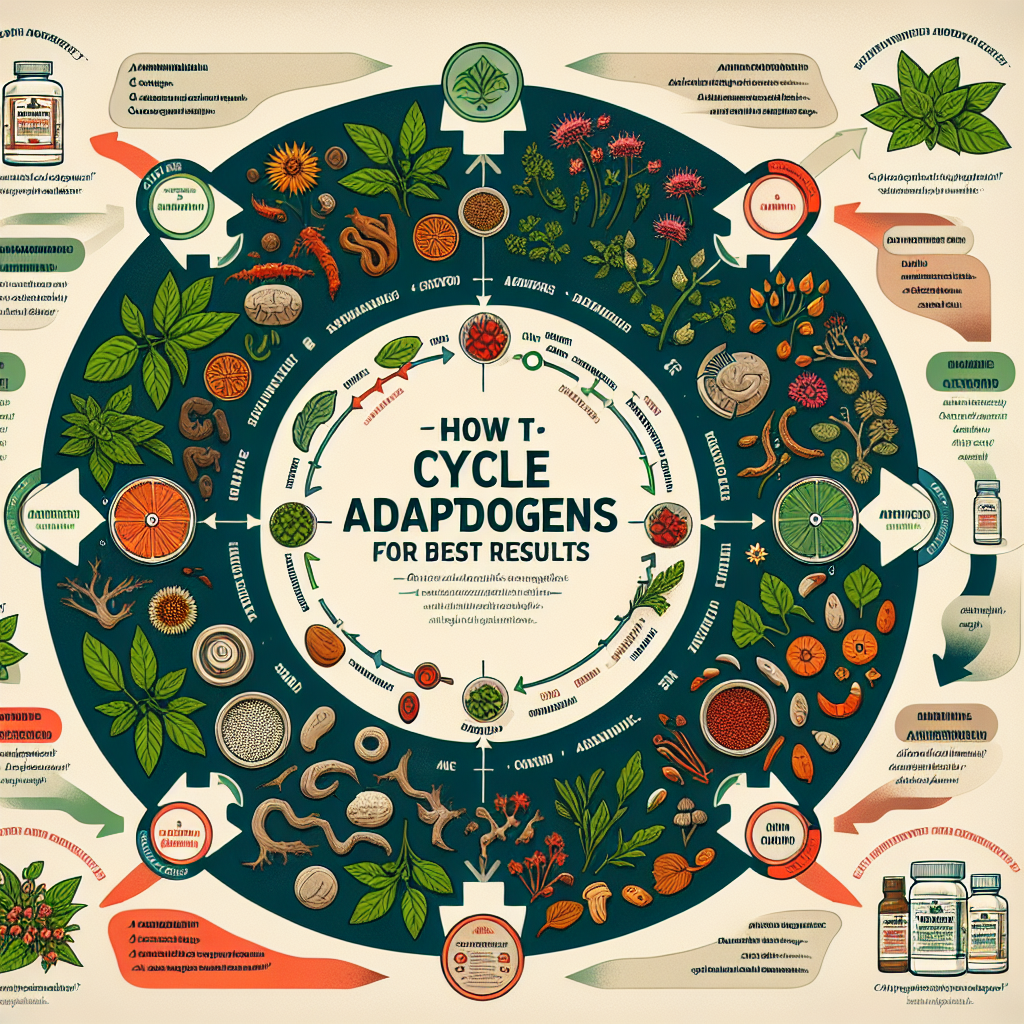How to Cycle Adaptogens for Best Results

Discover the best ways to cycle adaptogens for optimal results! Learn the right techniques, timings, and types of adaptogens to use for your health and wellness. Don’t wait, start your journey to a healthier you today. Visit My Vibrant Vitality now!
Maximizing Benefits: A Guide to Cycling Adaptogens
Adaptogens, a class of herbs and mushrooms that help the body adapt to stress, have been used for centuries in traditional medicine. They are known for their ability to balance, restore, and protect the body. However, to maximize their benefits, it’s essential to understand how to cycle adaptogens effectively.
Cycling adaptogens refers to the practice of alternating between different types of adaptogens or taking breaks from them altogether. This method is believed to prevent the body from becoming too accustomed to a particular adaptogen, which could potentially reduce its effectiveness over time. Moreover, cycling allows the body to experience the unique benefits of different adaptogens, as each one has its own set of properties and effects.
The first step in cycling adaptogens is to identify which ones are best suited to your needs. For instance, if you’re dealing with chronic stress, you might choose adaptogens like ashwagandha or rhodiola. On the other hand, if you’re looking to boost your immune system, you might opt for reishi or astragalus. It’s also worth noting that some adaptogens, such as holy basil and cordyceps, have a broad spectrum of benefits and can be useful in various situations.
Once you’ve selected your adaptogens, you can start incorporating them into your routine. A common approach is to take one type of adaptogen for a certain period, say a month or two, then switch to another. This allows your body to fully experience the benefits of each adaptogen before moving on to the next. However, it’s crucial to listen to your body during this process. If you notice any adverse reactions, such as digestive issues or sleep disturbances, it may be a sign that you need to adjust your regimen or take a break.
Another method of cycling adaptogens is to use them seasonally. This approach is based on the idea that our bodies have different needs depending on the time of year. For example, during the colder months, you might benefit from adaptogens like Siberian ginseng or reishi, which are known for their immune-boosting properties. Conversely, in the warmer months, you might opt for adaptogens like schisandra or rhodiola, which can help the body cope with heat and physical exertion.
In addition to these strategies, it’s also important to consider the concept of synergy when cycling adaptogens. This refers to the idea that certain adaptogens can enhance the effects of others when taken together. For instance, ashwagandha and holy basil are often combined for their complementary stress-relieving properties. However, it’s essential to do your research or consult with a healthcare professional before combining adaptogens, as not all of them may work well together.
Lastly, remember that while adaptogens can be a powerful tool for supporting overall health, they are not a substitute for a balanced diet, regular exercise, and adequate sleep. These lifestyle factors play a crucial role in managing stress and promoting optimal health.
In conclusion, cycling adaptogens can be an effective way to maximize their benefits and prevent the body from becoming too accustomed to them. By carefully selecting your adaptogens, listening to your body, and considering factors like synergy and seasonality, you can create a cycling regimen that meets your unique needs and supports your overall health.
Understanding the Cycle: How to Use Adaptogens for Optimal Results

Adaptogens, a class of herbs and mushrooms that help the body adapt to stress, have been used for centuries in traditional medicine. They are known for their ability to balance, restore, and protect the body. However, to get the best results from these powerful plants, it’s essential to understand how to cycle them properly.
Cycling adaptogens refers to the practice of alternating between different types or blends of adaptogens, or taking breaks from them altogether. This method is believed to prevent the body from becoming too accustomed to a particular adaptogen, which could potentially reduce its effectiveness over time.
The first step in cycling adaptogens is to choose the right ones for your needs. There are many different types of adaptogens, each with its unique benefits. For example, ashwagandha is known for its ability to reduce stress and anxiety, while rhodiola rosea can help increase energy and endurance. It’s important to do your research and consult with a healthcare professional to determine which adaptogens are best suited to your individual health goals.
Once you’ve selected your adaptogens, the next step is to determine the appropriate cycle for each one. This can vary depending on the adaptogen and your personal health needs. Some experts recommend taking adaptogens for a period of six to eight weeks, followed by a two-week break. Others suggest a more flexible approach, where you listen to your body and take breaks as needed.
During your “on” weeks, it’s recommended to take your adaptogens consistently. Most adaptogens can be taken daily, but the dosage can vary depending on the type and your individual needs. It’s important to start with a lower dose and gradually increase it over time, as this allows your body to adjust to the adaptogen and reduces the risk of side effects.
During your “off” weeks, it’s crucial to give your body a break from adaptogens. This allows your body to reset and prevents it from becoming too accustomed to the adaptogen. During this time, you can focus on other aspects of your health, such as maintaining a balanced diet and getting regular exercise.
It’s also worth noting that while cycling adaptogens can be beneficial, it’s not necessary for everyone. Some people may find that they get the best results from taking the same adaptogen consistently, without any breaks. This is particularly true for those with chronic conditions, who may need the consistent support that adaptogens provide.
In conclusion, cycling adaptogens can be a powerful tool for optimizing their benefits. By choosing the right adaptogens for your needs, determining the appropriate cycle, and taking them consistently, you can help your body adapt to stress, boost your energy levels, and improve your overall health. However, it’s important to listen to your body and consult with a healthcare professional to determine the best approach for you. Remember, everyone’s body is different, and what works best for one person may not work as well for another.
The Art of Cycling Adaptogens: Achieving the Best Results
Adaptogens, a class of herbs and mushrooms that help the body adapt to stress, have been used for centuries in Ayurvedic and Chinese medicine. They are known for their ability to balance, restore, and protect the body. However, to achieve the best results from these powerful plants, it’s essential to understand the art of cycling adaptogens.
Cycling adaptogens refers to the practice of alternating between different adaptogens or taking breaks from them altogether. This method is believed to prevent the body from becoming too accustomed to a particular adaptogen, which could potentially diminish its effectiveness over time. Moreover, cycling allows the body to experience the unique benefits of different adaptogens, as each one has its own set of properties and effects.
To begin cycling adaptogens, it’s crucial to first identify your health goals. Are you looking to reduce stress, boost energy, improve sleep, or enhance cognitive function? Different adaptogens have different strengths. For instance, Rhodiola Rosea is known for its energy-boosting properties, while Ashwagandha is often used for stress relief. Once you’ve identified your goals, you can select the adaptogens that align with them.
Next, consider the duration of your cycle. Some experts suggest cycling adaptogens every two to three months, while others recommend shorter cycles of four to six weeks. The duration can depend on several factors, including the adaptogen itself, your individual response, and your health goals. It’s important to listen to your body and adjust your cycle as needed.
During your cycle, it’s also beneficial to take your adaptogens in a rotation. This means taking a different adaptogen each day or week. This method can provide a broader range of benefits and prevent over-reliance on a single adaptogen. For example, you might take Rhodiola on Monday for an energy boost, Ashwagandha on Tuesday for stress relief, and Lion’s Mane on Wednesday for cognitive enhancement.
After completing a cycle, it’s advisable to take a break from adaptogens. This rest period, often referred to as a “washout,” allows your body to reset and prevents it from becoming too accustomed to the adaptogens. The length of the washout can vary, but it’s generally recommended to last at least a week.
Lastly, remember that while adaptogens can be powerful tools for health and wellness, they are not a substitute for a balanced diet, regular exercise, and adequate sleep. These lifestyle factors are the foundation of good health, and adaptogens are most effective when used in conjunction with them.
In conclusion, cycling adaptogens is an art that requires careful consideration of your health goals, the adaptogens themselves, and your body’s responses. By practicing this method, you can maximize the benefits of adaptogens and support your body in adapting to stress. As always, it’s important to consult with a healthcare professional before starting any new supplement regimen. With their guidance, you can navigate the world of adaptogens and find the best approach for your unique needs.